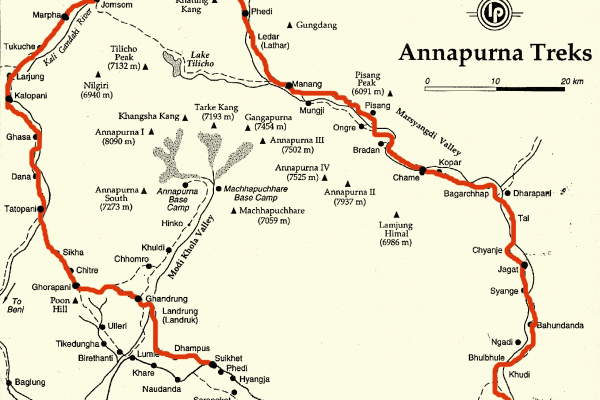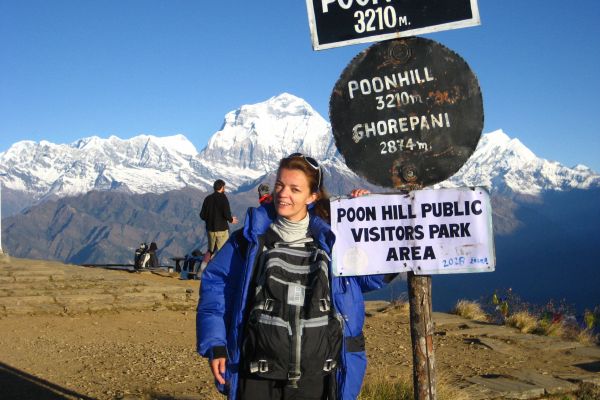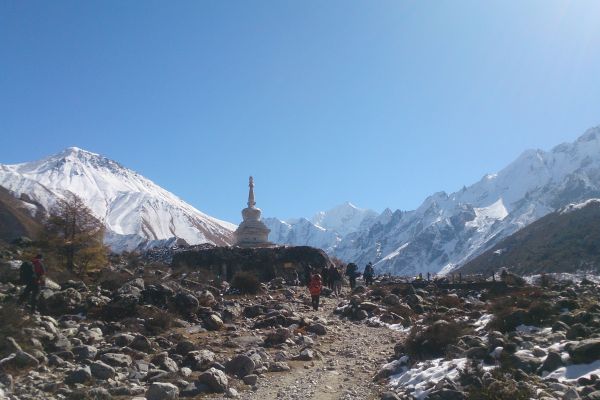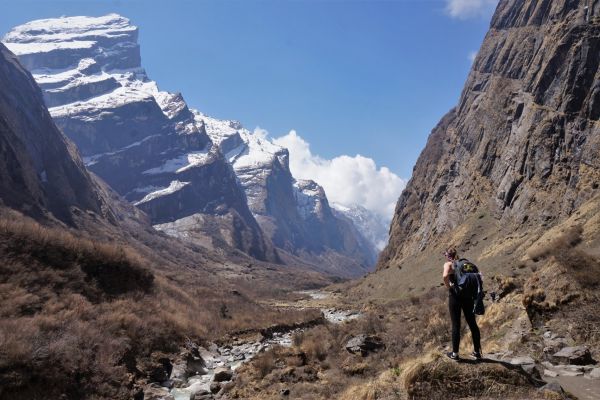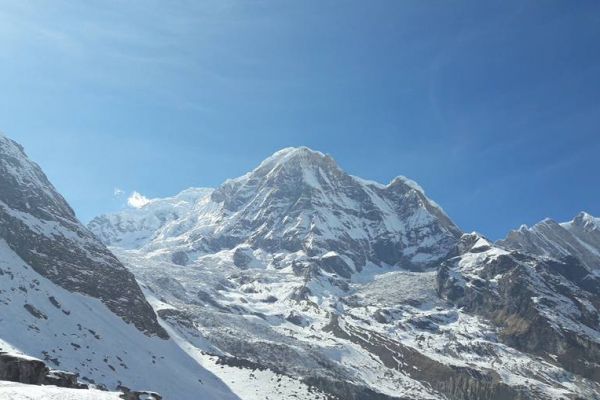- Trip Code : NTEAPT4
- Trip Duration : 14 Days
- Trip Level : Demanding
- Trip Max Altitude : 4500
- Trip Start Location : Kathmandu
- Trip End Location : Kathmandu
- Trip Route : Kathmandu-Pokhara-Ghandruk-Poonhill
- Trip Best Season : March-April & August-November
Trip Highlights
- Tunning 360 degrees view of the Annapurna, Dhaulagiri, Machhapuchhre, Nilgiri, Tukuche Peak.
- Cross dramatic river gorges above the Kali Gandaki River.
- Passing Poon Hill, Ghandruk, Tatopani.
- Exploring the beautiful Gurung Villages.
- Trek through greenery rhododendron and Pine.
- Hike up to Poonhill to watch sunrise and sunset and mountain ranges.
- Spectacular views of Annapurna I, Annapurna South, Dhaulagiri, Machhapuchre etc.
- Visit Ghorepani, Gurung museum and enjoy ethnic Gurung culture Walk through the forests of bamboo, rhododendron, pine, and juniper
- Witness the largest suspension bridge over the Kali Gandaki River.
Trip Information
Recently opened, the Annapurna panorama trek is one of the most famous destinations in the Annapurna region of Nepal. This overwhelming and exiting Annapurna panorama trek is unfolding with the stunning Himalayan views including two above 8000m mountains (Mt. Annapurna 8091m and Dhaulagiri 8167m,), beautiful landscape, 18 snow-capped splendid mountains of two different Himalayan range, nice terrace fields, various ethnic settlements (Gurung /Pun), several Rhododendron forests and many more. During our fascinating trail, we can enjoy with warm and generosity of the mountain people and get rare opportunity to observe their unique culture and traditions. It is one of the most famous trekking trails to discover the beauty of Annapurna.
The dramatic profile of the magnificent and highest mountains in the Annapurna region is really rewarding. Following beautiful dense forests and marvellous mountain settlements of Ghandruk, Ghorepani Poon Hill, Tadapani, and trek through one of the famous well-trodden routes and exploring the diverse ethnic groups is really amazing. One of the finest, short and easy treks also known as the Annapurna Poon hill trek. This natural paradise provides us with the unbelievable altitude ranges and moderate climate in the background of the Himalayan vistas such as; Mt. Machhapuchhre (6993m), Manaslu (8157m), Annapurna I (8091m), Dhaulagiri (8167m), and other frequent mountains along the world’s deepest Kali Gandaki gorge from the renowned viewpoint called Poon Hill are simply majestically unforgettable.
This amazing Annapurna Panorama trek begins from the beautiful village called Nayapul. Our representative guide will take you through Gurung village namely Hile, Tikhedunga, Ulleri, Ghorepani. As you reach Ghorepani, you will also discover the famous viewpoint called Poon Hill (3210m), where you will get chances to have great views of an impressive sunrise and spectacular views of the Annapurna Himalayan range. After exploration and a photo shot in Poon Hill, you will again descent down to Ghorepani and continue heading to the Dobato and eventually reach Annapurna Mulde hill for the best Himalayan views of the Annapurna region. Spring and autumn are the best seasons for the Annapurna Mulde peak and Annapurna Panorama trek in Nepal.
Note:- Above mention information is just the guideline and a standard template of what we provide. The trip can be customized at your request to accommodate your specific requirements.
Short Itinerary
- Day 01 - Arrival in Kathmandu (1,300m/4,264ft)
- DAY 02 - Kathmandu Sightseeing
- Day 03 - Kathmandu to Pokhara
- Day 04 - Drive to Phedi and trek to Pothana (1990m/6527ft)
- Day 05 - Pothana to Landruk (1565m)
- Day 06 - Landruk (1565m) Ghandruk Village (1940m/6360ft).
- Day 07 - Trek Ghandruk to Tadapani (2710m/8891ft)
- Day 08 - Tadapani to Ghorepani (2850m/9350ft)
- Day 09 - Ghorepani to Ghara (1700m/) via Poonhill (3210/10531ft)
- Day 10 - Ghara to Tatopani (1190m)
- Day 11 - Tatopani drive to Pokhara (823m/2700ft) via Kusma (1500m)
- Day 12 - Pokhara to Kathmandu
- Day 13 - Kathmandu rest day and farewell dinner
- Day 14 - Final Departure, Transfer to International Airport for connecting flight
- Day 01 Arrival in Kathmandu (1,300m/4,264ft)
- DAY 02 Kathmandu Sightseeing
- Day 03 Kathmandu to Pokhara
- Day 04 Drive to Phedi and trek to Pothana (1990m/6527ft)
- Day 05 Pothana to Landruk (1565m)
- Day 06 Landruk (1565m) Ghandruk Village (1940m/6360ft).
- Day 07 Trek Ghandruk to Tadapani (2710m/8891ft)
- Day 08 Tadapani to Ghorepani (2850m/9350ft)
- Day 09 Ghorepani to Ghara (1700m/) via Poonhill (3210/10531ft)
- Day 10 Ghara to Tatopani (1190m)
- Day 11 Tatopani drive to Pokhara (823m/2700ft) via Kusma (1500m)
- Day 12 Pokhara to Kathmandu
- Day 13 Kathmandu rest day and farewell dinner
- Day 14 Final Departure, Transfer to International Airport for connecting flight
Price Includes
- Airport / Hotel / Airport pick up & drop off service by a private tourist vehicle.
- Standard twin-sharing accommodation in a three-star hotel in Kathmandu including breakfast (2 nights).
- Guesthouse accommodation during the trek in mostly twin-share and occasionally dormitory-style rooms
- All standard meals during the trek ( Breakfasts, Lunches and Dinners).
- Local gov licensed English-speaking trekking guide.
- The required number of local staff and porters to carry your luggage during the trek. We assign one porter for every two guests.
- Food, accommodation, salary, insurance, equipment and medicine for all staff.
- Annapurna Conservation permits and TIMS permit for trekking.
- Ground Transport service Kathmandu - Pokhara - Kathmandu including necessary vehicle service
- Free Nepal Travel duffel/kit bag and sun hat (yours to keep).
- All our government taxes, vat, tourist service charges.
- Official expenses.
Price Does not Include
Lunch and dinner in Kathmandu. Depending on your budget, it may cost about USD 15 to USD 20 per person.
- Travel Insurance(compulsory!), which covers emergency high-altitude rescue and evacuation (See the travel insurance page.)
- International airfare and airport departure tax (See the international flights page.)
- Nepal entry visa - You can obtain the visa easily upon your arrival Airport in Kathmandu
- Tourist Visa with Multiple Entries for 15 days can be obtained by paying USD 25 or equivalent foreign currency.
- Similarly, Tourist Visa with Multiple Entries for 30 days and 90 days can be obtained by paying USD 40 and 100 respectively. Please bring 2 copies of passport size photos.)
- Alcoholic, hot and cold drinks.
- Personal trekking equipment.
- Tips for trekking staff and driver (tipping is expected).
- Any others expenses that are not mentioned in the 'Price Includes' section
Trekking equipment and clothing needed for this trek
- Warm fleece hat with ears cover or balaclava.
- Sun hat and scarf to cover face.
- Good polarized sunglass (uv protector).
- Cold proof polypropylene tshirt (2/2 half and full sleeve).
- Wind proof fleece jacket and thermal down tshirt.
- Waterproof shell jacket and Gore-tex jacket.
- Light weight poly-liner gloves and wool or fleece gloves(1 pair each).
- A pair of expedition mittens.(waterproof shell).
- Underwears.
- Light weight cotton pants and hiking shorts.(1 pair each)
- A pair of light and expedition thermal bottoms.
- A pair of fleece trousers and A pair of waterproof shell pants.(breathable fabric)
- A pair of socks.(Thin lightweight inner and thick warm wool hiking socks).
- Hiking shoes with spare laces.
- Light sandals/shoes for camp.
The price per person for the Small group Journey is fixed as stated below. There is also the option of private and tailor made journey best suited for you, your family and friends. The discount is subjected to increase with the number of people in your group. Bigger the group better the discount so group bookings are highly encouraged.
Frequently Asked Questions
- All your departure is guaranteed to run?
- Do I need to tip my guide and porters? How much would that be?
- Can I add extra days to my trek or trip?
- Do you use Yaks and porters on the trek or do we carry all of our own gear?
- Will there be a place to store items clothing not require for the trek?
- Can I charge my digital camera, mobile or other equipment on my trip?
- Is there any communication while we are on trekking?
- Do you guys have a PAC portable altitude chamber?
- If I am sick can I continue the trek next day after a day rest?
- What if I am badly sick in the Mountain?
- Is Nepal Travel Expedition staff insured?
- What safety measures are in place? What safety equipment do your guides carry with them on the trek to deal with altitude sickness/accident?
- Do your guide have trekking guide certificate from the government tourism center? Have they received first aid training for high altitude?
- What is the weather and temperature like in trekking?
- What is the best session for this trekking?
- What is your cancellation policy?
- Is it possible to reserve a trip now pay deposit later or do I have to pay deposit at booking reservation?
- Do we book own international flights to and from Nepal?
- What mode of transportation do you use?
- How much additional money do I need per day for the trek?
- What are the opportunity will I have for the shower along the trek?
- What is the drinking water facilities in the mountain?
- If I am vegetarian, is that a problem?
- Is the food in mountain prepare to international standard in terms of safety?
- What are the Toilet facilities in the tea house or guest house in the trekking route?
- What short of accommodation can I expect in Kathmandu and in the trekking?
- What types of extra document do I need?
- Can I obtain visa for Nepal upon on arrival at airport?
- Will somebody come to pick me up at the airport upon my arrival?
- What types of Shape do I need to be in this trip?
Trip Note:- During the trip you might face different problems such as weather, local politics, transport or a multitude of another factor that are beyond our control could bring change in the programmed. However every unlikely that the itinerary would be substantially altered, if the alternative way is necessary, then the tour leader will take a decision that the best alternative option. We try to make understand everything clear that we can to minimize its effect but we can not ensure the unseen result of changes or delays.
Why this trip make different?
Nepal Travel Expedition works closely with One of the main supporter's Charity service in Nepal. And contribute 10% of the tour cost for Orphan Childrens (sherpa Outdoor Foundation) We support them in many different ways.
Donation and Charity!
Nepal Travel Expedition donates 10% of its annual revenue to Sherpa Outdoor Foundation Orphan Children Home Which is Located in Lalitpur one can visit while you are in Nepal after or before the trip. We support Children's for Food, School, Clothes, Medicine also supporting stationery materials to Government School which is located at Lamjung district trying to build a library for them where they could find a different book to read. For this project, we are trying to collect donations.
Sponsorship and Partnership (volunteering programmed)
One of the major activities of Sherpa outdoor Children home in Lalitpur is fully conducted and collaborate with Nepal Travel Expedition and sister concern organization Nepal wildlife safari. The Volunteering concern programmed delivered by Nepal Travel Expedition and Sherpa Outdoor Foundation aims to mobilize a team of experts and interested individuals as an economic measure in providing human capital for education, health, community to share teaching skill various Government school in a different part of the country and community to delivered humanity skills also in our children home.

